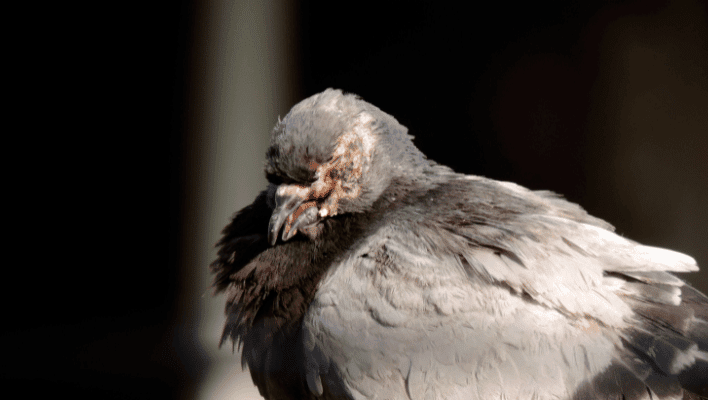Introduction
Worldwide, avian illnesses pose a serious danger to the health and welfare of birds. Maintaining the health of birds requires knowledge of the many forms, preventative measures, and available treatments for these viral diseases. The numerous bird diseases will be covered in this article, along with effective prevention strategies and treatment methods. By following the right procedures, bird owners may protect their feathered friends from any dangers and guarantee their general wellbeing.

Table of Contents
Avian Diseases: An Overview
Avian diseases are a broad category of ailments brought on by a variety of pathogens, including as bacteria, viruses, fungi, and parasites. These illnesses may have negative impacts on bird populations, causing illness, death, and even the endangerment of some species. Understanding the typical avian illness kinds is essential for taking preventative action and managing their effects.
Common Types of Avian Diseases
Avian Influenza: Protecting Against Bird Flu
Birds are the main victims of the highly contagious viral virus known as avian influenza, or “bird flu.” It could result in severe respiratory sickness and high mortality rates in infected groups, posing a serious threat to the health of birds. Some avian influenza strains are also zoonotic, which means they can spread to people. Strict biosecurity protocols, vaccination campaigns, and ongoing surveillance are essential for preventing avian flu.
Newcastle Disease: Safeguarding Avian Health
Numerous bird species are impacted by the highly contagious viral virus known as Newcastle disease. In particular in chicken, it can result in high death rates and reduced egg production by causing respiratory, digestive, and neurological problems. Preventing the spread of Newcastle disease requires the implementation of efficient bird disease prevention tactics, including as stringent biosecurity measures, vaccination programs, and routine surveillance.
Psittacosis (Avian Chlamydiosis): A Hidden Threat
Chlamydia psittaci is the bacterium that causes psittacosis, sometimes referred to as avian chlamydiosis. Parrots, cockatiels, and other Psittacidae family birds are particularly affected. Humans can also contract psittacosis, which causes pneumonia and flu-like symptoms. Correct avian illness diagnosis, quarantine procedures, and excellent hygiene practices are critical to preventing the spread of this hidden menace.
Aspergillosis: Combating Fungal Infections
The respiratory system of birds is frequently impacted by the fungal infection known as aspergillosis, which is brought on by Aspergillus species. In severe situations, it can cause respiratory discomfort, weight loss, and even death. Maintaining clean, well-ventilated surroundings, eliminating mold-contaminated places, and reducing stress factors that can impair the bird’s immune system are all necessary for aspergillosis prevention.
Avian Pox: Defending Against Viral Infections
A viral ailment known as “avian pox” affects several bird species worldwide. It causes wart-like growths to appear on the skin, beak, and eyes of affected birds, which affects their ability to see, feed, and be healthy overall. By using efficient pest management methods, maintaining high cleanliness, and avoiding contact with infected people, avian pox can be avoided.
Other Infectious Diseases
Aside from the illnesses described, common parasites, respiratory infections, and outbreaks of other avian diseases can also affect birds. Maintaining avian health and preventing disease transmission need adequate cleanliness, an understanding of the symptoms associated with these illnesses, and the implementation of preventive measures.
Prevention Strategies: Protecting Birds from Infections
In order to protect avian health, it is crucial to put into place reliable prevention measures.
Here are some critical actions to consider:
- Bird Vaccination Programs: Consult a veterinarian who specializes in avian medicine to create the best immunization plans for your birds, taking into account the most common diseases in your area.
- Biosecurity Measures: In order to stop the introduction and spread of pathogens, strong biosecurity procedures should be established. Limit the amount of outside access that birds have, handle trash properly, and keep your premises clean and sanitary.
- Bird Quarantine Protocols: Before introducing new birds to existing populations, quarantine them. During this time, possible diseases can be observed, examined, and tested to identify them before they spread..
- Disease Diagnosis: To achieve a precise and prompt diagnosis of any suspected avian diseases, carefully collaborate with a veterinarian who specializes in avian medicine. Quick treatment and containment are made easier by early detection.
- Hygiene and Sanitation: Keep the equipment, surroundings, and bird habitats clean and hygienic. When handling birds, keep surfaces clean and sterile, get rid of contaminated items, and maintain appropriate personal hygiene..
Treatment Options: Caring for Infected Birds
Swift and effective treatment is essential in the unfortunate event of an avian illness outbreak. Depending on the particular ailment and its severity, different treatments may be available. It is always advised to get advice from a licensed veterinarian with knowledge of avian medicine for a precise diagnosis and individualized treatment strategies.
Treatment options for avian diseases may include:
- Medication: Depending on the underlying infection, antibiotics, antiviral meds, or antifungal treatments may be recommended. These drugs support the bird’s rehabilitation while assisting in the fight against the infections.
- Supportive Care: In addition to medication, supportive care can boost the bird’s immune response and speed up recovery by ensuring that it receives the right nourishment, maintaining ideal environmental circumstances, and reducing stress.
- Isolation and Quarantine: To stop the spread of disease, infected birds may need to be kept apart from healthy ones. To reduce the hazards of transmission, careful adherence to quarantine protocols is required.
Frequently Asked Questions
Question 1: What are avian illnesses, exactly?
Viral, bacterial, fungal, and parasitic infections are examples of avian diseases, which are disorders that afflict birds. The population and health of birds may be significantly affected by these diseases.
Question 2:How can I avoid avian infections, second?
By putting into practice strategies like bird vaccination programs, biosecurity guidelines, routine surveillance, and maintaining good cleanliness and sanitation in bird enclosures, you may prevent avian diseases.
Question 3:What are the most prevalent avian illness types?
Bird flu, respiratory illnesses, fungal infections, viral infections, and zoonotic diseases are examples of common avian diseases.
Question 4: How are avian diseases identified?
Clinical examinations, laboratory investigations, and symptom analyses are used to diagnose avian illnesses. For a precise diagnosis, it is crucial to speak with a veterinarian skilled in avian medicine.
Question 5: What options are there for treating avian diseases?
Medication, supportive care, isolation and quarantine, and individualized treatment programs can all be used to treat avian diseases. For the right course of therapy, speaking with a skilled avian veterinarian is essential.
Conclusion
Bird populations may be significantly impacted by avian diseases, which could endanger their survival. We can safeguard the health and wellbeing of birds by being aware of the many types, taking preventive action, and receiving treatment in a timely manner. Always seek the advice of a veterinarian who specializes in avian medicine for information on avian diseases, prevention tactics, and treatment alternatives. We can guarantee our feathery friends a healthier future by banding together..

